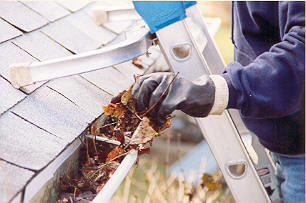How To Clean Your Rain Gutters
By Mike Milliman
 Rain gutters protect your house from water damage, but they only do their job when free of clogs. To keep your gutters flowing freely, you need to clean them periodically.
Rain gutters protect your house from water damage, but they only do their job when free of clogs. To keep your gutters flowing freely, you need to clean them periodically.
The conventional wisdom says to clean your rain gutters twice a year – once in the fall and once in the spring. In fact, this is the minimum frequency at which you should clean them. If you live in a rainy climate or have trees near your roof, you will need to clean your gutters more often.
Check your gutters once a month during the rainy season to make sure they are clean. In addition to leaves and pine needles, check for small seeds and nuts. If allowed to build up, these can leave a tar-like residue that’s hard to remove.
To clean your gutters you’ll need the right tools, and the most important tool for this job is a steady ladder.
If you have a low roof, a step-ladder may be enough to do the job. Otherwise you will need a stabilized extension ladder. Lean the top of the ladder against your roof and place the bottom on level ground about one quarter of the ladder’s length away from the wall.
Leaning an extension ladder against your gutters can damage them. You can avoid this by using a ladder stabilizer, which is a metal triangle that attaches to the ladder, allowing it to rest safely against a wall and keeping its weight off of your gutters.
Remember never to stand on the top step of your ladder. If your ladder isn’t tall enough for you to comfortably reach your gutters, don’t be a hero, just get a bigger ladder.
Once your ladder is in place, you’ll need a plastic bucket to store debris. Hang the bucket from a ladder step with an S-hook. Don’t be tempted to hang the bucket from your gutters, since the added weight can damage the gutters.
Next you’ll need a tool for scraping leaves and other debris from your gutters. A trowel or garden spade will do the job, but avoid sharp tools that can gouge your gutters. Some hardware stores also sell a specialized “gutter scooper,” which is basically a long-bladed trowel shaped to fit most gutters.
Begin near a downspout and scoop out debris, working your way along the gutters and away from the downspout.
After you have cleaned out the debris, flush the gutters with a garden hose. This is also a good time to check for leaks in your gutter system.
Next, check for clogs in your downspouts. Insert your garden hose into the top of the downspout and turn on the water. Compare the flow from the hose to that washing out of the downspout. A slow flow means you have a clogged downspout.
Unclogging your downspouts is undoubtedly the hardest part of cleaning your gutters. You can try blasting water through the downspout, but this can potentially worsen the clog.
In many cases it’s better to disassemble the downspout. Take out the elbows, which are where clogs usually occur, and clean them with your tools.
Another option is to use a plumber’s snake (sometimes called a plumber’s auger or drain auger). Essentially an auger with a flexible tube, the plumber’s snake lets you bore through the clog. Just be sure to buy a plumber’s snake that’s wide enough for your rain gutters.
Instead of cleaning your own gutters, you can a hire service to do the job for you. The cost depends on the size and height of your house. To clean the gutters on a two-story, 2,000 square-foot home with 180 feet of gutters will cost anywhere from $90 to $200.
Another option is to install gutter screen or gutter covers, which help keep leaves and debris from getting into your gutters. These cost anywhere from $0.50 – $6.00 per foot of gutter, depending on the type of system you buy.
Mike Milliman is a managing partner of GutterSupply.com, the leading online seller of gutter supplies and equipment. Visit their web site to learn more about gutter cleaning and gutter guards.
Article Source: http://EzineArticles.com/?expert=Mike_Milliman